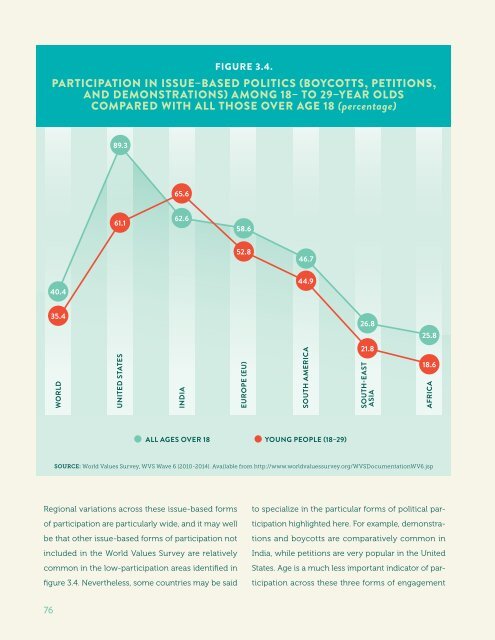YOUTH CIVIC
JieguI2U
JieguI2U
You also want an ePaper? Increase the reach of your titles
YUMPU automatically turns print PDFs into web optimized ePapers that Google loves.
FIGURE 3.4.<br />
PARTICIPATION IN ISSUE–BASED POLITICS (BOYCOTTS, PETITIONS,<br />
AND DEMONSTRATIONS) AMONG 18– TO 29–YEAR OLDS<br />
COMPARED WITH ALL THOSE OVER AGE 18 (percentage)<br />
89.3<br />
65.6<br />
61.1<br />
62.6<br />
58.6<br />
52.8<br />
46.7<br />
40.4<br />
44.9<br />
35.4<br />
26.8<br />
25.8<br />
WORLD<br />
UNITED STATES<br />
INDIA<br />
EUROPE (EU)<br />
SOUTH AMERICA<br />
21.8<br />
SOUTH-EAST<br />
ASIA<br />
18.6<br />
AFRICA<br />
ALL AGES OVER 18 YOUNG PEOPLE (18–29)<br />
SOURCE: World Values Survey, WVS Wave 6 (2010-2014). Available from http://www.worldvaluessurvey.org/WVSDocumentationWV6.jsp<br />
Regional variations across these issue-based forms<br />
of participation are particularly wide, and it may well<br />
be that other issue-based forms of participation not<br />
included in the World Values Survey are relatively<br />
common in the low-participation areas identified in<br />
figure 3.4. Nevertheless, some countries may be said<br />
to specialize in the particular forms of political participation<br />
highlighted here. For example, demonstrations<br />
and boycotts are comparatively common in<br />
India, while petitions are very popular in the United<br />
States. Age is a much less important indicator of participation<br />
across these three forms of engagement<br />
76


